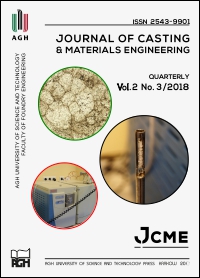Novel Measurement Method to Study Thermal Aspects of Molding Mixture Decomposition
DOI:
https://doi.org/10.7494/jcme.2018.2.3.63Abstract
A wide variety of molding mixtures are extensively used in the process of the sand casting of metal components today. The sector is continuously developing in production volume; moreover, the expectations of customers are increasing on a monthly basis (also from a quality point of view). Even though mold and core manufacturing are well-organized routines in most foundries, technological problems still appear that can lead to technological problems and casting defects. These trends are forcing metal casters to come up with fitting strategies to solve their daily production challenges, while their suppliers are expected to keep up the continuous development of their existing foundry products and to find innovative solutions as well as new material combinations. Research on molding materials and their properties must, therefore, take a step forward accordingly to generate the necessary new knowledge to understand the behavior of mold and core mixtures during casting.
This paper summarizes the latest results of a novel measurement method suitable for studying the degradation characteristics of different molding materials from a new perspective. The fundamentals of the method are based on a thermal analysis, focusing on the heat-absorption behavior of greensand and two types of chemically bonded sands regardless of the binder type and amount or the manufacturing process.
Downloads
References
Stefanescu D.M. (2015). Thermal Analysis – Theory and applications in metal casting. International Journal of Metalcasting, 9(1), 7–22. Doi:10.1007/BF03355598.
Krupiński M., Krupińska B., Rdzawski Z., Labisz K. & Tański T. (2015). Additives and thermal treatment influence on nonferrous alloys. Journal of Thermal Analysis and Calorimetry, 120(3), 1573–1583. Doi:10.1007/s10973-015-4497-0.
Bartosová M., Pribulová A., Eperjesi S. & Futás P. (2018). Analyisis of cooling curves of nodular cast iron. Journal of Casting and Materials Engineering, 2(1), 1–4. Doi:10.7494/jcme.2018.2.1.1.
Diószegi A., Diaconu V.L. & Fourlakidis V. (2016). Prediction of volume fraction of primary austenite at solidification of lamellar graphite cast iron using thermal analyses. Journal of Thermal Analysis and Calorimetry, 124(1), 215–225. Doi:10.1007/s10973-018-7088-z.
Grabowska B., Malinowski P., Szucki M. & Byczyński L. (2016). Thermal analysis in foundry technology. Journal of Thermal Analysis and Calorimetry, 126(1), 245–250. Doi:10.1007/s10973-016-5435-5.
Krajewski P.K. & Piwowarski G. (2015). Range of thermal conductivity changes of wet green foundry sand during casting solidification. Archives of Metallurgy and Materials, 60(3B), 2391–2395.
Krajewski P.K., Piwowarski G., Żak P.L. & Krajewski W.K. (2014). Experiment and numerical modelling the time of plate-shape casting solidification vs. thermal conductivity of mould material. Archives of Metallurgy and Materials, 59(4), 1405–1408. Doi:10.1515/amm-2015-0390.
Lidumnieks K., Svidró J.T. & Diószegi A. (2017). The effect of various production parameters on the heat absorbing capacity of greensand. International Journal of Cast Metals Research, 31(1), 7–13. Doi:10.1080/13640461.2017.1348005.
Svidró J.T., Diószegi A., Svidró J. & Ferenczi T. (2017). Thermophysical aspects of reclaimed sand addition to the epoxy-SO2 coremaking system studied by Fourier thermal analysis. Journal of Thermal Analysis and Calorimetry, 130(3), 1779–1789. Doi:10.1007/s10973-017-6612-x.
Svidró J.T., Diószegi A., Svidró J. & Ferenczi T. (2017). The effect of different binder levels on the heat absorption capacity of moulding mixtures made by the phenolic urethane cold-box process. Journal of Thermal Analysis and Calorimetry, 130(3), 1769–1777. Doi:10.1007/s10973-017-6611-y.
Downloads
Published
Issue
Section
How to Cite
Accepted 2018-10-15
Published 2018-10-31


